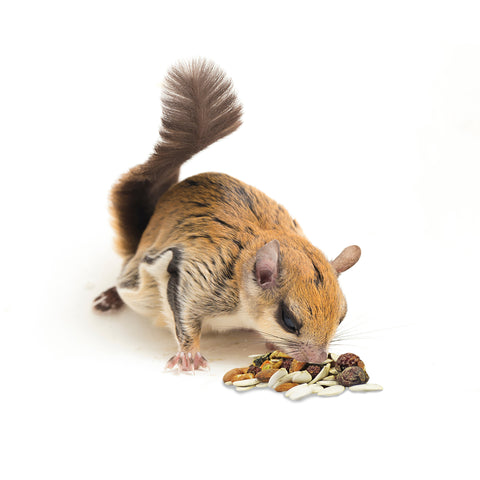
Southern Flying Squirrels, scientifically known as Glaucomys Volans, represent a delightful and unique addition to the world of exotic pets. Nestled within the enchanting forests of the Southern and Eastern United States, these creatures possess an allure that has captivated animal enthusiasts for generations. In this comprehensive guide, we delve into the fascinating realm of Southern Flying Squirrels, exploring their characteristics, care requirements, and the joys of nurturing these charming companions.
Understanding the Southern Flying Squirrel
Measuring a mere 5 to 6 inches in length, the Southern Flying Squirrel stands as the smallest among its tree-dwelling counterparts. Cloaked in hues ranging from gray to chestnut, adorned with a pristine white belly, and featuring large, expressive eyes adapted for nocturnal adventures, these elusive creatures boast a distinctive appearance. Notably, a unique flap of skin, extending from the back leg to the front wrist, enables their remarkable gliding capabilities through the forest canopy.
Despite their diminutive stature, Southern Flying Squirrels exude a remarkable intelligence and endearing personality, forging profound bonds with their human companions. However, due to their shy nature, encountering these elusive creatures in the wild remains a rare privilege.
Embracing Southern Flying Squirrels as Pets
For those contemplating the joys of exotic pet ownership, Southern Flying Squirrels offer a rewarding and enriching experience when provided with proper care and attention. These charming creatures, when nurtured from a young age, develop deep bonds with their owners, exhibiting affectionate behaviors such as recognizing their owner's voice and eagerly seeking their company.
Breeding and Bonding
The journey of nurturing Southern Flying Squirrels begins with thoughtful breeding practices and dedicated bonding efforts. Providing breeding pairs with suitable nesting boxes fosters a conducive environment for the arrival of newborns, typically numbering between 3 to 4 per litter. It's crucial to initiate the bonding process during the early stages of a squirrel's life, preferably around 5 1/2 to 6 1/2 weeks of age, to cultivate a strong connection with their human caretakers.
Creating the Perfect Habitat
A spacious and well-equipped habitat is essential for ensuring the health and happiness of Southern Flying Squirrels. Ample cage space, adorned with cage furniture such as nest boxes, branches, and essential amenities like salt spools and calcium blocks, provides a stimulating environment conducive to their well-being.
Nutrition and Diet
The suggested foundation of a squirrel’s diet should be Exotic Nutrition Premium Squirrel Blocks, developed to meet the nutritional needs of captive squirrels. Feed the Premium Squirrel Blocks as the main diet, along with supplemental food sources including Exotic Nutrition's Squirrel Complete, Beneficial Blocks, and Garden Fresh Re-Hydrate. Maintaining a balanced and nutritious diet is paramount for the health of Southern Flying Squirrels. Formulated foods, such as Exotic Nutrition's Squirrel Complete, offer a comprehensive blend of essential nutrients, complemented by occasional treats like pecans and supplemental offerings such as mealworms or dried insects.
Health and Well-being
Preventative measures, such as providing calcium supplements and ensuring a clean living environment, safeguard Southern Flying Squirrels against potential health concerns. Additionally, social interaction and mental stimulation play pivotal roles in promoting their overall well-being, underscoring the importance of dedicated attention and care from their human companions.
Enriching Lives, One Squirrel at a Time
In conclusion, Southern Flying Squirrels exemplify the captivating allure of exotic pet ownership, offering companionship, affection, and endless delight to those willing to embark on the journey of nurturing these charming creatures. With proper care, attention, and a commitment to fostering strong bonds, Southern Flying Squirrels enrich our lives with their playful antics and endearing personalities, transforming our homes into havens of joy and companionship.
Explore Our Range of Squirrel Products
Discover a world of possibilities with our premium selection of squirrel products, meticulously curated to meet the diverse needs of Southern Flying Squirrels and their dedicated caretakers. From the spacious confines of the Congo Cage & Starter Pack to the essential amenities of the Squirrel Nest Box and the nutritious offerings of Deluxe Squirrel Diet Squirrel Food, our collection ensures a fulfilling and enriching experience for both you and your beloved companions. Experience the joy of exotic pet ownership with our exquisite range of squirrel products, designed to elevate your bond with these enchanting creatures to new heights.
Ready to Shop? Shop By Pet or Shop By Category
Got Questions? Browse more free Blogs or Contact Us with any inquiries regarding our products.
Notice: Exotic Nutrition cannot provide specific care guidelines on an individual basis. Please consult a veterinarian or experienced breeder.
Exotic Nutrition is proud to serve hundreds of universities, zoological parks, veterinarians, research centers and other institutions seeking to advance the health and well-being of exotics worldwide. See a full list of institutions using our products here.
Exotic Nutrition has a heart for animals in need. Through regular donations to rescues, rehabilitators, and special fundraiser events, Exotic Nutrition is making a significant impact in the lives of animals. See a full list of our charitable donations here.

Comments (2)
Flying squirrels are awesome! So friendly, bold and playful! They are the cutest animals in the world. And they LOVE honey peanut butter! 🥰
I would like to get a flying squirrel
Leave a Comment